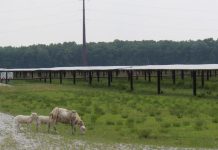SLOW DEATH OF MALLS AND BIG BOX RETAILERSÂ
by Joe Wallace, CEO & Chief Innovation Officer
Coachella Valley Economic Partnership
Malls and big box stores have a serious problem. The comfort and price advantage of online shopping has taken market share from both big boxes and malls that are not dealing in unique products. Some shopping is done out of need and other shopping is more about the experience of being catered to and finding unique items.
The big box stores that offer basic necessities or home improvement items for the most part have little differentiation at the product level. They seldom offer a unique shopping experience or offer products that can’t be purchased online or elsewhere. Often these days their online division competes directly with their big box stores.


Consumers who are internet savvy or who are pressed for time are migrating to online shopping for basics. Just this week at the CVEP offices we received a shipment of everyday items such as toiletries, paper towels, and other non-perishable items. The delivery took less than 24 hours and costed less than it was priced at the big box store 2 miles from our office. It saved CVEP at least an hour of a productive employee’s time and we saved money by shopping online. Households are no different, so I would submit to you that the long term trend will be toward an ever increasing percentage of purchases of non-perishable goods toward online shopping. This is as natural in the progression of business models as the displacement of small mom and pop shops with big boxes was 30 years ago.
This migration to online shopping has more to do with innovations that provide better pricing and convenience than it does with the general state of the economy.
It is commonly asserted that there was overbuilding of big box stores in the years leading up to the Great Recession. That is unlikely. Large retail outlets use demographic analysis based on current conditions and future projections to select new locations. The conditions in 2007 obviously fit the criteria for such decisions at that time. What happened is that the business conditions changed making their decision process obsolete. Their crystal ball was clouded by an economy that destabilized in the wake of the housing crisis.
During the Great Recession, households adapted to job losses and stagnant wages by spending less money. As the economy improved, wages never recovered and online options became more attractive. This was and continues to be a perfect storm to squeeze the top line and bottom line of big box retailers. It is not widely known than the profit margins at big box retailers are only in the 3% range. The fixed costs of operating do not decrease when the spending decreases making once successful stores cross the line into losing operations with small reductions in revenue.


Empty storefronts in areas that were formerly thriving is an even bigger problem. The difficulties associated with starting a store are and have always been entrepreneur confidence and access to capital. Before the Great Recession startup funding often came from the equity in entrepreneurs residences. In my neighborhood, today’s prices are still 15% – 20% below the levels of 2008. What this means to the capital formation process is that home equity loans as a source of startup funds are much more problematic than they were 10 years ago.
As any banker will tell you, without equity one is not eligible for an equity based loan, no matter how confident an entrepreneur may be.

As for downtowns, there needs to be a critical mass on which to build from. In 2009 I attended a seminar on some steps that are necessary to revitalize struggling downtowns, art’s districts, and etcetera. The formula was very simple. The minimum needs are ten different types of restaurants, ten retail stores that offer unique items with broad appeal and ten establishments that are open after dark. Some cities have crossed this hurdle while others have not. It is not as easy as it sounds to inspire and enable 30 entrepreneurs to fly in formation.
On the brighter side, CVEP held a reception this Thursday night for the members of the Palm Springs iHub and their enthusiasm has never been higher. Three of our companies already have more bookings than they delivered in all of 2016 while another two have combined to raise over a million dollars in equity investment just in the past month. Another one of our companies that is in the industrial solar space has large installations scheduled worldwide for 2017 and has been in hiring mode. Of course these are not big box retailers, but they are customers so more profits for them will mean more revenue at the retail level. Most of them do their shopping online.
If big boxes continue down the path toward obsolescence, these buildings with either have to be turned into small unique retail spaces, industrialized, or maybe even demolished to make the land available for more productive assets. The best local adaptive reuse project in the works is to turn the former Palm Springs Mall on Tahquitz Canyon Way into the West Valley Campus of the College of the Desert. That is making lemonade from lemons. Similarly the Palm Springs Accelerator Campus utilized local funding to adapt a collection of seven vacated buildings into what is recognized as one of the most impactful manufacturing business incubators in California.
Innovation coupled with ambition and capital has always been the basis for prosperous adaptation. The cities and towns of America that are successful in sowing the seeds of innovation will reap the harvests of the future. Big box retailers will not be a long term problem for innovators. That is why the big box retailers are all following their customers into the convenient world of online shopping as we speak.
FOOTNOTE: Written by 


Joe Wallace, CEO & Chief Innovation Officer
Coachella Valley Economic Partnership





I like the big box stores and malls. When I’m looking for a major purchase I visit them (Best Buy, Sears, Target, WalMart, Sams, etc.) to get a hands-on look and ask the sales rep questions. Then I come home and find the best price on-line. I do give the big box stores and mall shops an opportunity to match the on-line price but usually the can’t. Usually they can’t. Their loss, my savings. And that’s what it’s all about: the bottom line.
Comments are closed.